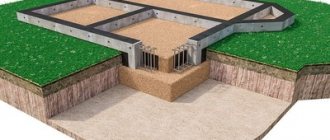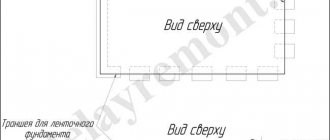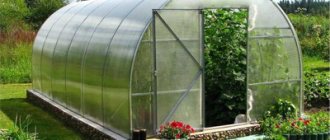A foundation for a fence made of corrugated board is required due to the characteristic features of the material for making the fence. The higher the structure, the more windage it has. From below, a fence made of corrugated sheets is subject to soil heaving. If you only fill the base for the support pillars, then there is a high risk that after a while you will find the entire structure made of corrugated sheets turned out at the same time as pieces of concrete. Therefore, the arrangement of the foundation for the fence must be treated very responsibly.
Corrugated fence
Types of foundation
A fence to protect a personal garden can be built on the following types of foundation:
- Monolithic base. In this case, the support pipes are placed on a concrete layer located in the ground. This method is quite expensive, because it is usually used on marshy soil.
- Columnar supports. This foundation involves installing pillars in holes and then filling them with concrete. The supports are attached at intervals of 2–3 m, but when using a profiled sheet that has a high windage capacity, the step between the posts should be kept to a minimum. This type of foundation is relatively inexpensive, unlike a monolithic foundation.
- Strip foundation. This base is the most reliable, but not economical. Can be installed on clay or loose soil. It is also often used when installing a blind area near a house, constructing various ancillary structures in DNT, etc. The foundation is installed along the perimeter of the territory. Reinforcing bars protrude from the base at regular intervals for fastening the profile sheet. The foundation is called strip-and-pillar if at the base there is a cushion with load-bearing pillars. A fence made of corrugated sheets on a strip foundation can be easily built with your own hands, even without special construction skills. At the same time, a shallow concrete strip does not require significant material costs.
- Stone base. It can hardly be called a foundation, since it does not go deep into the ground. The stone base consists of boulders, metal profiles, cement mortar and has a height of up to one meter. A fence is installed directly above the stone foundation, but this base is not suitable for a profiled sheet.
Installation diagram of a fence made of corrugated sheets
What to paint with?
To improve the appearance of a concrete foundation, you can apply decorative plaster on it by spraying it with a special textured plaster or colored mortar using a regular broom.
The base under the fence can also be painted with special paints for concrete. You can also find colorful edging or border coverings at hardware stores. Acrylic, latex, epoxy, polyurethane, and alkyd compounds can be used to paint concrete bases.
Acrylic paint is made on a water basis with the addition of acrylic dyes. Due to the presence of copolymers in their composition, it creates a polymer layer on concrete surfaces that protects the foundation from the effects of environmental factors. This paint is easy to apply, dries quickly and is economical in consumption.
Latex paint is made up of water, pigments and polymers. Sometimes it may contain silicone or acrylic resins. This paint can be applied to the concrete base immediately after it has hardened.
Epoxy compounds are considered the most durable foundation paints. They can protect a concrete base for almost a quarter of a century. The paint consists of two components - epoxy resin and a special hardener, which are mixed immediately before application. The composition is applied in two layers
Epoxy coatings are vapor permeable, which is very important for concrete bases, and are resistant to exposure to the sun, acids and alkalis.
Polyurethane paint also consists of two components that must be combined immediately before applying the paint composition. The paint is applied in two layers. The advantage of polyurethane paints is that they improve the properties of concrete, are frost-resistant, form a protective coating, and close microscopic cracks and pores in concrete.
Alkyd paints are made from alkyd resin. They have a rich palette, dry quickly, are resistant to sunlight, frost-resistant, and are economical in consumption.
But before choosing one or another product, you need to pay attention to whether it is suitable for a given climate. Paint should only be applied to a dry and free of dirt concrete base.
How to choose the type of foundation for a fence
The base for a fence made of corrugated sheets must be selected taking into account the following factors:
- the likelihood of future intake being washed away by groundwater;
- before you build a fence from a metal profile with your own hands with a foundation, you must definitely take into account the type of soil and the level of probable subsidence during seasonal temperature fluctuations;
- when arranging a fence near highways and railway tracks, one should not forget that the base must withstand high vibration and loads from the movement of underground layers of soil;
- during the construction of a fence from corrugated sheets, choosing the type of base and the height of the fence itself, you need to take into account the likelihood of bending due to the high windage of the material;
- When constructing a fence made of metal sheets, despite the light weight of the structure, it is necessary to take into account that any type of soil can sag under the weight of the fence.
Before installing a fence, you still need to consult with specialists regarding carrying out work in a certain area.
Structure construction drawing
Selection of concrete grade and reinforcement diameter
For the strip base, medium-density concrete grades are traditionally used - M200 or M250.
Considering the relatively low load from the weight of the canvas, and in appropriate conditions (location in a lowland, among tall buildings or dense trees that protect the structure from the wind), less dense M150 concrete can be used.
Its load-bearing capacity is quite sufficient to support a sheet of corrugated sheets in the absence of additional impacts.
NOTE! Concrete is a material with large quality tolerances. By purchasing M150 concrete, you can get a material that practically corresponds to the M100 grade, which significantly reduces the strength of the tape
Therefore, it is recommended to use the minimum grade M200 to avoid density discrepancies.
The most suitable reinforcement diameter for a tape of this size is 10 mm for working (ribbed) rods, and 6 mm for auxiliary (smooth) rods. If the width of the tape exceeds 30 cm, you can use 12 mm working rods, but such a base width is rare and only for specific types of fences.
How to pour a foundation for a fence made of corrugated sheets
As a rule, a strip foundation is poured under a fence made of corrugated sheets.
Preparatory work
Before making a foundation for a fence made of corrugated sheets, you need to draw a drawing of the future fence. It marks slopes and obstacles that cannot be removed (for example, a pipeline). Then you need to clear the area for future fencing, get rid of bushes and stones in areas where construction work is taking place.
Scheme of constructing a fence from corrugated sheets with pouring the base on a slope
Next, the base for the foundation is marked. To do this, stakes are installed at the corners of the fence, as well as at the site of the future gate and wicket.
Scheme of the foundation for a fence with pouring concrete
Much attention must be paid to areas where there is a slope. If possible, the height difference is leveled out, and the required marks are also made. When all the stakes are installed, a rope is stretched between them.
Sketch of the location of the fence
Trench
A trench is dug along the perimeter of the future fence. The width is made taking into account the width of the base, usually about 50 cm, and the depth is 60–80 cm. The walls need to be compacted well and the verticality must be checked using a level. As for the bottom, in this case leveling is not required, since in the future the sand and gravel cushion will be filled.
Example of formwork assembly
In areas of the foundation where columns from a profile pipe will be attached, additional recesses must be made. What can you use a garden auger for? The pits are made 1.2–1.4 m deep and 25–40 cm in diameter.
Sketches for installing supports
If the height of the fence is more than 2 m, it is necessary to increase the depth of the supports. In this case, the following rule is adhered to: 40% - underground, 60% - above ground level.
Scheme of forming a fence frame from corrugated sheets
A fence made of corrugated sheets is a relatively lightweight structure that does not load the soil. But a fence with a height of more than 2 m and a section width of 2.5 m has a high windage, which requires the use of strong supports.
Option to create a fence with ventilated vents
As a rule, the following types of racks are used:
- wooden or concrete pillars;
- profile pipes;
- screw piles;
- brickwork.
Variety of options for installing fence supports
Pillow organization
The sand and gravel layer will help the base resist increased heaving forces during frosts, and will also increase the stability of the foundation and fence.
Concrete blocks
Before choosing concrete blocks for the foundation, you need to familiarize yourself with the parameters and technical characteristics of this building material:
- They are finished products that are produced in a factory from heavy concrete or expanded clay concrete, reinforced or unreinforced. To increase frost resistance and moisture resistance, plasticizing components are added to the composition.
- Blocks can also be solid or hollow. For their production, rubble concrete, silicate concrete or heavy concrete are used. For ease of movement and transportation, they are equipped with mounting loops made of reinforcement, which ensures reliable installation in trenches.
- High strength of products is achieved due to a special “formulation” of the composition, where all components are selected in exact proportions. They are made in special rectangular shapes, into which reinforcement is placed and the prepared composition is poured. To increase the density of the structure, the blocks are vibrocompressed and then steamed in special industrial chambers for at least eight hours.
- Blocks made of expanded clay concrete are used when arranging the foundations of fences of various types or low buildings of lightweight construction, since they have less strength than blocks made of heavy concrete. The latter are used in the construction of foundations for individual or industrial buildings.
The main characteristics of concrete products are dimensions and weight, which are directly related to each other
They have standard sizes, which are established by GOST, and are produced in several size ranges:
- length from 80 cm to 2.4 m;
- width - 30 and 60 cm;
- height – 30 and 60 cm.
Depending on the dimensions, the weight also changes accordingly: from 340 kg to 2 tons. In individual low-rise construction, as a rule, foundation blocks measuring 120x30x60 cm or 240x80x60 cm are used.
The cost also has several values, which depend on the size, quality of the material used in production, class of blocks and manufacturer, and range from 700 rubles to 2500 rubles per piece.
How to build a fence from corrugated sheets with your own hands with a foundation
After pouring the base and installing the supports, it is necessary to secure the logs and screw the corrugated sheet to the sheathing.
Lathing fasteners
Installation of logs is carried out using a welding machine, clamps or bolts. The most durable fastening is the use of electric welding. The logs are installed parallel to each other. For a fence up to 1.8 m high, 2 logs are installed; for a fence over 1.8 m, 3 veins are installed. The lathing is treated with anti-corrosion compounds in the welding areas.
Crossbar layout
Crossbars should be installed at a distance of 22–27 cm from the top of the fence and ground level. If you choose a smaller distance, then it is difficult to screw in the screws at right angles.
Diagram of a fence made from corrugated sheets
Corrugated sheet fasteners
At this stage, the corrugated sheet is secured to the joists with self-tapping screws. The connection of the canvases is done with an overlap.
Sketch for screwing in fasteners
Self-tapping screws are screwed into the bottom of the wave, then the mount is screwed into every third wave. During installation, you must avoid damaging the surface of the corrugated sheet.
Rules for placing sheets and fittings
Possible errors during fastening:
- a very loosely screwed self-tapping screw causes leakage;
- a crookedly screwed self-tapping screw creates a rupture in the surface of the corrugated sheet and insufficient adherence of the rubber gasket, which is the cause of further corrosion process;
- a self-tapping screw that is screwed in too tightly violates the integrity of the material coating.
In the photo you can see successful examples of finished fences made of corrugated sheets.
Corner equipment
Features and tricks when building a foundation
- For a standard fence (2 meters), the depth of the tape is 30-40 cm; if the plan is for a high fence (from 2 to 5 meters), the depth should be up to 60 cm. In this case, you will get not 2 horizontal levels, but 4.
- Rotary and corner posts must be thicker and more reliable, since the load on them increases. The depth of the hole is determined by the ratio of 1 to 3, and the diameter is 10 cm greater than the diameter of the base.
- If the profiled sheet can be machined or begins to rust, you will not have the need to reconstruct the foundation itself. It will be quite simple to replace the corrugated sheeting, which will not take much time.
Which base is suitable?
The optimal bases for light, but sailing fences made of profiled metal are recognized as:
- Monolithic, block, brick or rubble tapes with a width of 20 cm and a depth of up to 50 cm, optimal under normal operating conditions and medium loads.
- Columnar point support systems with a fully or partially reinforced lower part. This type of foundation has limited load-bearing capacity and does not tolerate soil movement during frost heaving. But when building a fence in dry and dense soils without clay inclusions, it will cost less than others with equal stability and durability.
- Pile-screw foundations , chosen when carrying out work in difficult and flooded areas. If the intermediate supports are heavy, such foundations are reinforced with monolithic grillages; in all other cases, the piping is lightweight.
On a note. The best option is selected after taking into account soil parameters, collecting all loads and calculating the dimensions of the base or vertical supports (if any).











